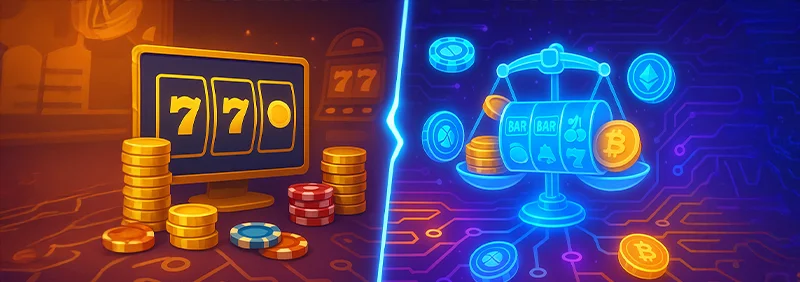Home > Casino Lab > Casino Web3 > Web3 vs Traditional Online Casinos: Who Holds the Future?
Web3 vs Traditional Online Casinos: Who Holds the Future?
Online casinos have been a driving force of the gambling industry for more than two decades, offering convenience, variety, and global accessibility. Yet the rise of Web3 technologies—blockchain, cryptocurrencies, NFTs, and DAOs—is creating a new wave of decentralized platforms that challenge the traditional model.
While conventional online casinos continue to dominate in size and recognition, Web3 casinos are pushing boundaries by offering transparency, ownership, and community governance. The battle between these two models raises a crucial question: who truly holds the future of iGaming?

The Strengths of Traditional Online Casinos
Traditional online casinos remain popular for good reasons. They offer user-friendly platforms, simple onboarding, and a wide selection of games from established providers. Their infrastructure is supported by strong regulation and licensing, which builds trust among players who prefer to gamble within clear legal frameworks.
Payment methods are familiar, ranging from credit cards to e-wallets, and customer support systems are robust, ensuring quick assistance when needed. In short, traditional casinos deliver accessibility and reliability, making them the go-to option for millions of players worldwide.
However, these platforms rely on centralized control, meaning operators hold all the power over games, payouts, and policies. Players must trust the casino, with little transparency into how odds are managed or how funds are handled. This centralized model leaves room for skepticism and creates a disconnect between operators and their communities.
The Promise of Web3 Casinos
Web3 casinos flip this model by leveraging blockchain transparency and decentralization. Every bet, payout, and random number can be verified on the blockchain, eliminating doubts about fairness. Payments are processed through cryptocurrencies and stablecoins, making them faster, cheaper, and borderless compared to traditional banking.
Another key advantage is player empowerment. Through DAOs and governance tokens, users can actively participate in decision-making, vote on platform updates, and share in the casino’s profits. NFTs further personalize the experience, giving players access to exclusive avatars, collectibles, and VIP privileges.
Web3 casinos also thrive on innovation. From immersive Metaverse environments to provably fair smart contracts, they are shaping a vision of gambling where entertainment, ownership, and finance converge.
Challenges on Both Sides
While traditional casinos benefit from stability, they often lag in innovation and continue to operate with opaque systems. Players who demand transparency and digital ownership may eventually migrate toward Web3 alternatives.
On the other hand, Web3 casinos face challenges of their own. Regulatory uncertainty remains one of the biggest barriers, as many governments have yet to adapt their laws to decentralized platforms. Technical complexity—such as managing wallets, private keys, and tokens—can also intimidate mainstream players. Additionally, blockchain platforms are still vulnerable to coding errors and exploits.
Both models must evolve to address these weaknesses: traditional casinos must embrace innovation, while Web3 casinos must simplify their user experience and navigate regulation.
Who Holds the Future?
The future of iGaming may not belong exclusively to one model. Instead, the industry could move toward hybrid casinos that combine the strengths of both worlds: the trust and regulation of traditional platforms with the transparency and innovation of Web3.
By 2030, it is likely that Web3 elements—such as crypto payments, provably fair games, and NFT-based loyalty programs—will become standard across most casinos, even those that started as centralized operators. The real winners will be the platforms that successfully balance trust, accessibility, and innovation, appealing to both mainstream players and blockchain enthusiasts.
Conclusion
The clash between Web3 and traditional online casinos is not a zero-sum game. While centralized platforms offer stability and familiarity, decentralized casinos bring transparency, ownership, and new experiences. The future of iGaming will likely be defined by a convergence of both models, where casinos adopt the best features of Web3 while preserving the trust and accessibility of established operators.
The next decade will reveal which platforms adapt fastest—and which ones risk being left behind.
